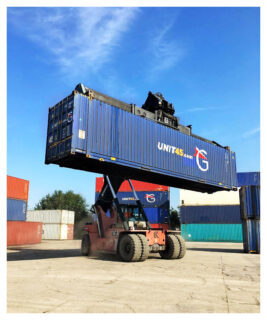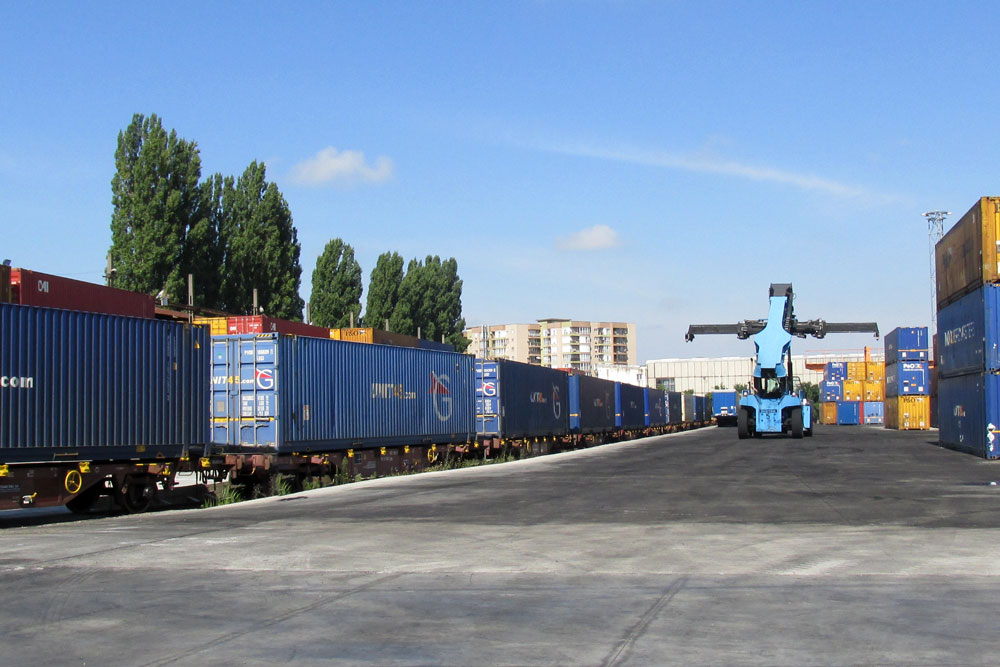Intensive work on the Trans-European Transport Network (TEN-T), changes in the directive concerning combined transport, three new transhipment terminals in Poland launched last year, and plans to build a railway line from Poland to Lviv are just some elements of the EU’s climate policy and national decisions for the development of intermodal transport. Together with Gopet Trans, we explain why this type of freight transport is gaining importance and is currently a focal point of international discussion.
Why are EU officials working on an integrated rail network? The reason, as indicated by calculations from the EU Council, is that only 1.9% of energy consumption in the EU is attributed to rail transport, responsible for just 0.4% of greenhouse gas emissions from this mode of transport. Rail is environmentally friendly and could be a game-changer for freight transport in the future. Therefore, nine corridors of the basic network are to be established, connecting railways with roads, maritime routes, inland waterways, as well as ports and airports across the Union. Changes supporting the shift of freight transport to more environmentally friendly modes of transport are the goal and a clear direction taken by the TSL industry, also in Poland. However, the challenges accompanying them require our attention.
“It is necessary to create coherent and transparent legal frameworks that will consider the specificity of intermodal transport and guarantee safety, environmental protection, and fair competition. These regulations should cover issues such as safety standards, charges for using transport infrastructure, insurance, and liability in case of accidents or damage to goods. Additionally, they should aim to eliminate national barriers and enable access to economic support measures,” adds Vasileva.
“The lack of adequate railway infrastructure makes the local transport market ineffective and non-competitive in the long run. Poland is part of the main European supply chains, and companies commissioning transport are paying increasing attention to decarbonization, hence the noticeable openness to adopting intermodal transport as part of their long-term ESG policies.
 On the other hand, customers also demand clear, accurate transit time indications, so the availability of goods for further production and sale is crucial. With delays and even disruptions caused by infrastructure, we cannot be competitive. Ideally, through the modernization of both roads and railways, we could create the right mix of services, utilizing these solutions efficiently,” comments Kamelia Vasileva, Chief Commercial Officer at Gopet Trans.
On the other hand, customers also demand clear, accurate transit time indications, so the availability of goods for further production and sale is crucial. With delays and even disruptions caused by infrastructure, we cannot be competitive. Ideally, through the modernization of both roads and railways, we could create the right mix of services, utilizing these solutions efficiently,” comments Kamelia Vasileva, Chief Commercial Officer at Gopet Trans.
This is being worked on by, among others, the European Commission, which has made further changes to the directive on combined transport (Directive 92/106/EEC). The revision of this document, intended to improve regulations, may ultimately discourage carriers and forwarders from choosing sustainable transport due to administrative barriers and overly complicated procedures. Comments on the amended directive were submitted in February by the International Road Transport Union (IRU).
Rail emits less
According to the Railway Transport Office, one train is needed to transport a cargo of 1000 tons, compared to at least 36 trucks in road transport. This illustrates the scale at which railways could operate in the future. Why such a conclusion? According to data from the Directorate-General for Mobility and Transport at the EC, the transport sector accounts for nearly one-quarter of greenhouse gas emissions in Europe. Almost three-quarters of this is attributable to road transport, with trucks generating one-quarter of emissions from road transport. To achieve net-zero greenhouse gas emissions, according to EU targets, only 26 years remain.
“The increase in emissions comes from increased road traffic resulting from economic development. Another factor could have been the neglect of investment in railway infrastructure compared to road investments. As a result, a significant portion of CO2 emissions may be due to traffic congestion and idle times in road traffic. Transferring some of the traffic from roads to railways could contribute to a real improvement. Additionally, road traffic could be more efficiently utilized in the first and last miles, while the longest stretch of the journey could be carried out by rail,” notes Vasileva, Gopet Trans.
Focusing on intermodality is one of the sustainable choices in transport, and this direction of development in the TSL industry is currently key. Electric trucks are no longer as distant a future as it may seem.
“However, they are still a costly investment, requiring well-developed infrastructure. Therefore, we must act here and now. At Gopet in 2022, we reduced carbon dioxide emissions by over 4.3 thousand tons compared to the previous year, using available intermodal solutions, and since 2013, this has been over 206.5 thousand tons less carbon dioxide. Moreover, over the past nine years of operation, we have redirected over 565 thousand tons of cargo to rail transport. We also associate intermodality with our subsequent projects and investments in Poland and Europe. Already today, we have several active solutions operating in Europe in cooperation with long-standing suppliers and partners, and we are intensively working on the development of more,” comments Kamelia Vasileva, Gopet Trans.
The potential is there
According to data from the Polish Development Fund for January 2024, road transport dominated freight transport in Poland (49.2% share). Rail comes second with a 41% share. At the same time, in December of the previous year, the mass of goods transported by trains was 6.5% lower than a year earlier. In Poland, which ranks third in terms of the length of railway lines in the EU, over 80 thousand tons of goods were transported internationally throughout 2022 by rail. Rail is seen as having the potential to make freight transport more sustainable and ultimately work better with road carriers, and investments are being made in this direction. It is worth mentioning that in the years 2014-2020, the EU allocated over 1.1 billion euros to support projects related to intermodality, with further EU initiatives in the plans. For example, in April 2023, the EU’s Transport Projects Center started pre-qualifying projects for further initiatives in the field of intermodal transport, as part of the National Recovery and Resilience Plan (KPO). The intensity of work on strengthening intermodality in Europe is also evidenced by the fact that Germany and Denmark have already started building a railway tunnel connecting Scandinavia with continental Europe.

